Rebecca Ashton sits in on a dressage clinic with an exceptional trainer
– she also took the photos
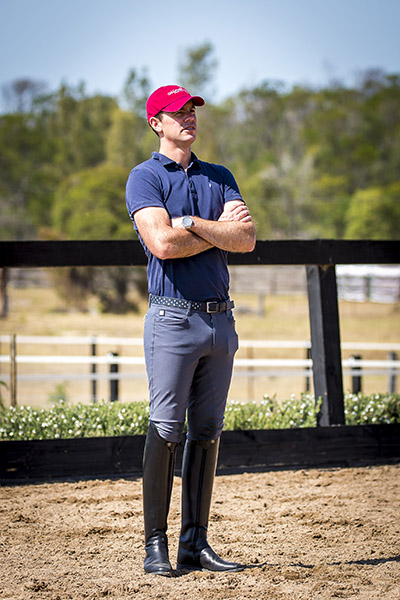
Stefan Wolff shines the light in numerous ways. Stefan is a living walking embodiment of the world’s most successful system of dressage training – the German Principles – which is not surprising since he learned his art under the tutelage of one of the great modern masters, Klaus Balkenhol, and then polished his communication skills in the USA before returning to Germany where he is a successful professional trainer – that is when he is not soaking up the warmth of one of his regular visits to Di White’s Sydney arena in Australia…
Stefan was focusing on getting the horses to respond to their riders; to become animated themselves, rather than run away from the aids. He also wanted good pushing power before collection was even considered. Good contact also figured large, and of course, perhaps the most important thing, patience. Lessons were spent consolidating these things before playing with the movements further down the track. Keeping in mind, most of these riders are familiar with Stefan’s way, and all had more than one lesson… working within a system is always a key to making good progress.

Brett Peel, had a few horses in front of Stefan, the first being HerzAss W, a six-year-old Trakehner mare owned by Suellen Saals. Stefan began with getting the tension out of the horse, and getting her to reach out of her frame a little more. “Tap tap the hind leg until she responds. When the back is up and soft, work with the hind leg. Better. The frame gets longer, that’s a good thing. Ride a half halt as if you want more frame, not less. Don’t be too careful about it. Things happen. You won’t find the perfect momentum if you’re worried that it’s too much. Let her drive more to the bit. Long rein again and if she blocks, don’t avoid it. Know it’s coming and be soft enough but steady and don’t fiddle with the rein.”
Spiralling exercises from the 20 metre circle worked on the mare’s alignment and to introduce some gymnastic work. “Bring the neck in front of the inside shoulder so the shoulders are 100% aligned with the bit. Now she isn’t dying or blocking. Spiral in so the neck comes more towards the inside shoulder. Just calmly move your hand. Don’t fiddle. If it takes three more strides, who cares. If she struggles, let her struggle. That’s the point. Don’t help her, let her sit in that situation and work it out. That was good. You waited. You felt it wasn’t going well so you waited for the shoulder to realign.”
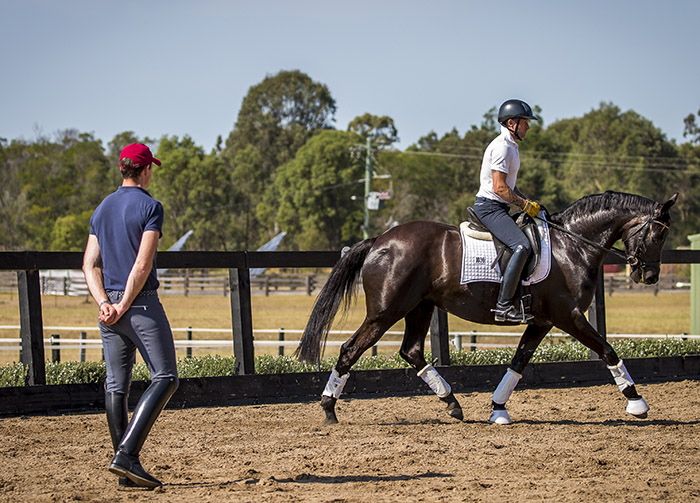
Next was a little recheck of the horse’s relaxation while changing her balance. Twenty metre circle left in counter flexion into 10 metre circle right and back onto the 20 metre circle left. “Everything stays the same. She shouldn’t change the straightness when she changes direction. I just don’t want her to snap into tension again.”
In transitions, the idea was to leave the horse alone a bit, trust yourself as a rider and wait for things to fall into place, so that tension is avoided, and the horse remains soft in the back. In the walk to trot transition: “Trust your aid. Even if it takes longer, don’t add to it. We don’t want her to rush in the aid and tighten the back. It’s only that you touch the horse. The entire horse moves forward, not that she runs off the hindleg. Stimulate the hind leg, don’t push her body away from it.”
In the trot work, “She can come to your leg and be a bit stronger on your leg, as long as she is staying responsive and not getting dull. Better if she’s light in front. Don’t push her off your seat or sit faster than the swing. Sometimes your leg pushes her off your seat. Know that you can use your leg to get a response, but leave her on your seat. If it takes longer, it takes longer. Her body can come back, but the hind leg should not hesitate.”
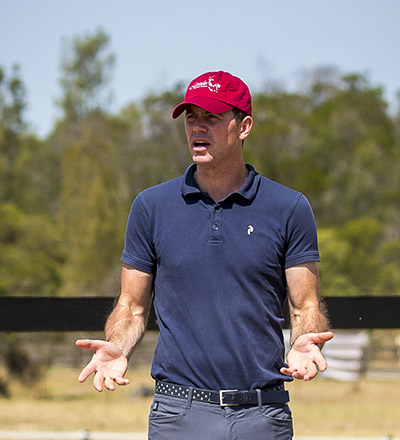
The sun was coming up and the big umbrella was being put up outside the arena. Knowing his mare, Brett wanted it to wait to after his lesson, but Stefan was having none of it. “No, focus, put it up. The second you focus on the umbrella, the horse does.” And it was immediately back to the work in canter. “Keep your inside hand ahead. If she’s not quite through to your inside leg, do something, do circles, don’t just waste the whole long side. She doesn’t want to use her inside hind leg that’s why she doesn’t want you to put your inside leg on. But you can always remind her how she used her body in the trot then take it back into canter again.”
The mare tried to avoid her inside leg being engaged, “Try and keep the contact even here. Then back to the trot spiral circles to get her back responding to the leg and engaging the hind leg before trying the canter again. Inside leg, outside rein and less collection. You have to fix it in good working canter. Let her come to your seat. Give to the stretch. Right. From there you can bring her back but keep the frame longer. Now canter again. Right. You want that momentum with the inside hind leg. You want that response. Transition to trot. Don’t slow down. Hands low on the crest and forward. More frame. Keep your leg on. Good work. Long rein.”
After a break it was back to the canter, “Try now to put her in a certain position and see if she has the nerve and the trust that she stays with you, not that she always just moves off you when you touch her. If you think about it, when you do changes for example, she needs to be solidly on your aids for three or so strides. So think of that. Don’t give so much. Don’t always give to loop the rein, just release the pressure. Let her settle under your seat and back.”
“Don’t let anything interrupt you. If there is a mistake, it’s not just that she comes off the aid, she sometimes gets you off the aid too. Keep her on your seat. If she trots, keep control. Don’t get lighter and off the aid. Don’t have it so it takes you five strides to recover. More collection on the hind leg and off the shoulder. There you go. That’s how she canters from now on!”
Stefan was trying to get Brett to keep the mare on his aids. Finding the point where it could happen, where Brett could rebalance and supple the mare and she would accept it without pushing her to the point of her having a tantrum. Moving her haunches around or sometimes her shoulders, taking her back to the trot, taking walk breaks. The exercises find the “uncomfortable” point and it was a matter of using the certain exercise to gymnasticise the horse, address the issue, but getting out in time so it isn’t too much for the horse.
more follows
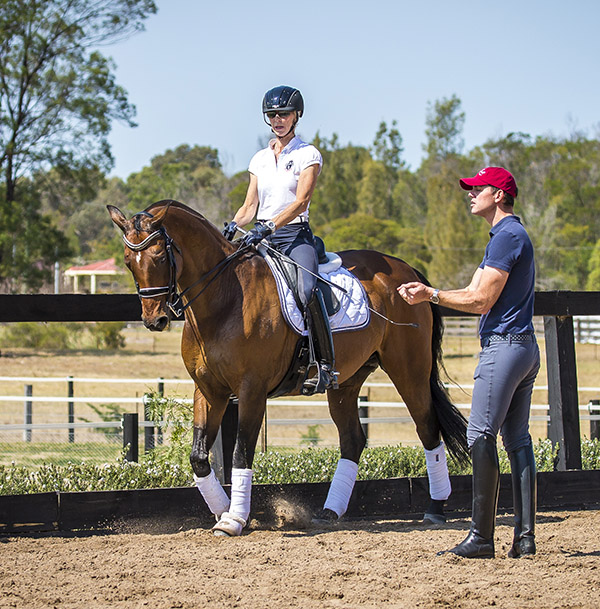
Gail Benson is also a Stefan regular with her 21-year-old Prix St George horse, the appropriately named Stefan.
The pair was asked to warm up in trot. “Make sure there are some variations, forward and back. Make sure you get a response from your leg. It’s not necessarily about power, but more suppleness in the horse’s body. It doesn’t always need to be much, but it’s about preparing the horse mentally as well as physically, not just working it round and round.”
“When he hangs on the bit, get a reaction from the leg. Trust your feeling. Don’t only hold, that’s never a good option.” The horse was getting a little stuck on the inside rein, “Spiral in to improve the diagonal aid. Inside hand is light and get him to react to your leg. The exercise only has sense when the horse does it with a supple body. The idea is that he gets better on your inside leg, that he accepts your inside leg better. Then if he gets heavy again, you don’t always have to spiral in, but you want a response to the inside leg again.”
Then a change of rein, “He’s more hollow to the left so you don’t want to do it as much to the left. Remember, the straightening work is not always the same left to right.”
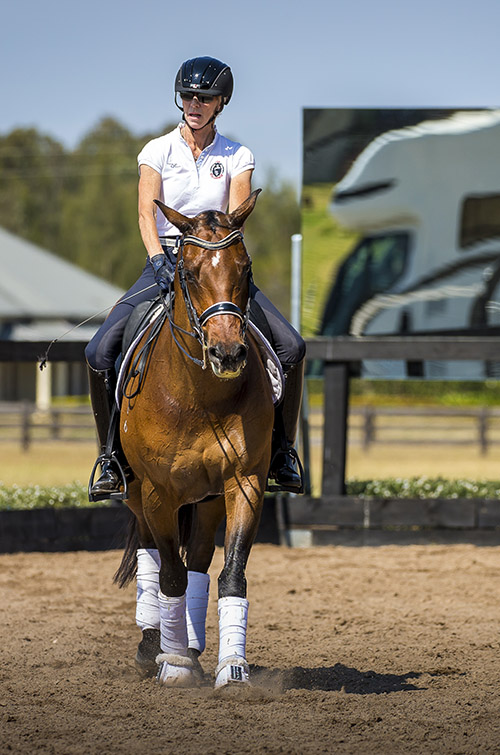
Time for a walk break but Stefan emphasised that the break didn’t mean to just dawdle around, which was easy to do in the heat! “If you do a walk break, do a proper walk break; a good extended walk or transitions from collected walk to extended walk or vice versa. All those things we don’t practice enough. Use your walk breaks to work on that.”
“More ground cover and more frame. Push your hand forward and the neck stays in front of your forward moving hand. He doesn’t need to come lower. He needs to push forward with his mouth and not downward. Stabilise with the neck. The neck could be used more powerfully. Build up a bit more pushing power.”
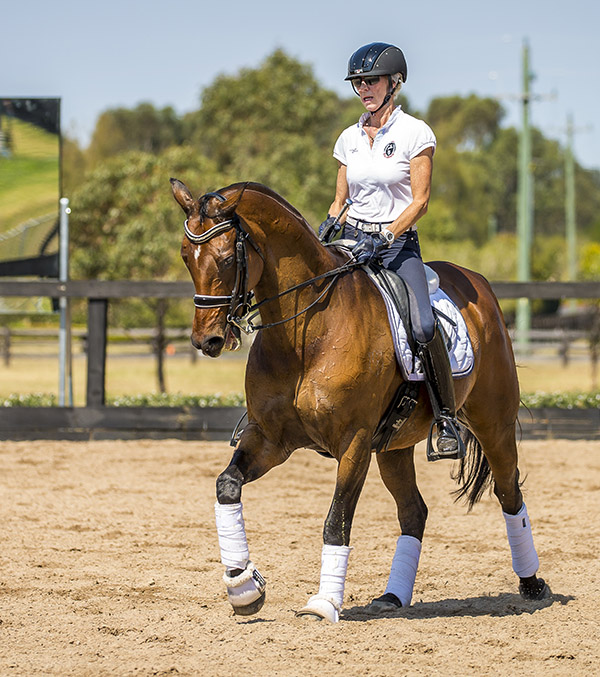
Next was canter work and it’s the German’s attention to detail that makes him so special. The horse and rider picture was nice but Stefan knew it could be better and insisted on a bit more rhythm and activity, “Even when he’s elevated, the neck should feel soft and ready to drop, responsive. The collection is fine, but he needs to be more responsive to the leg. Do something out of your comfort zone to get a response, don’t just go around and wait. He’s hanging on the inside rein, don’t pull on the inside rein. Use the outside rein and have the inside rein light. Not more flexion and bend, just a better quality of it. Less poll, more shoulder, and still a better response to the inside leg. Good, getting better. Transition to trot. Make it a proper transition. Always have a bend in place before you start the circle. Don’t fly into a circle with a straight horse. Always try to ride excellent transitions with good power and good bend. And that’s gymnastics, that response and reaction to you, and the efficiency of your aids and the exercises.”
Back into the canter to have a look at the half passes and Stefan reminded Gail to keep the quality of the canter right through the whole movement. “You might even need to go straight and circle half way through the half pass. Be ahead of him mentally. Trust your own skill that you can fix it. Have the nerve to interfere with him a little bit in the half pass. Don’t be too careful. You need to make a difference. When you have your horse between inside leg and outside hand in half pass, there’s no need to use your inside hand. Get rid of all the unnecessary aids.”
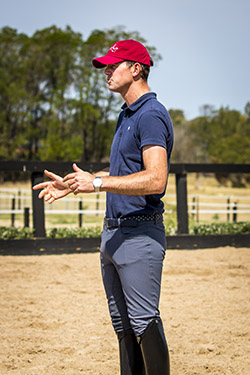
That carried through to the changes, “Ride with increasing energy, not decreasing energy. It’s not speed, but rather rising energy and collection. I want to see you improve it, not wait and hope there’s no mistake. I want to see you affect his entire body.”
There were no second measures when it came to lengthening the canter either, “Fly! Good job. None of this half hearted stuff. When you have him straight, go for it. Don’t waste your marks. When the technicals are right, he’s straight and in front of you, go for it.” That was enough for today….stretch, walk and finish.”
another combination follows
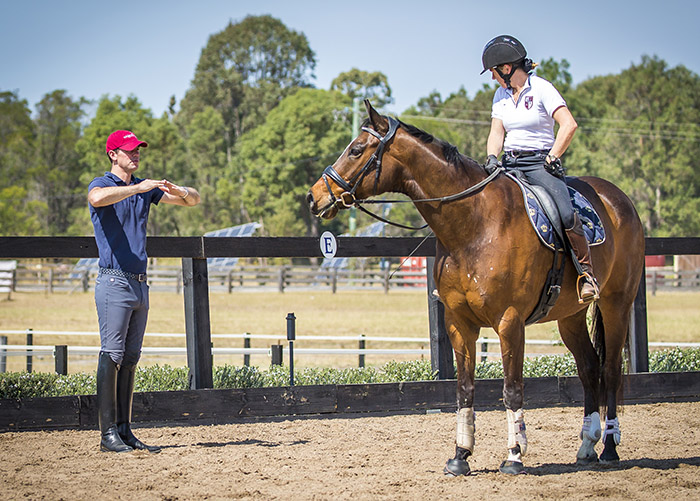
Debbie Eisenhauer-Rodney was on here 11-year-old Flash and both she and Stefan decided they needed to work on the bay’s dynamics. Stefan liked the horse’s steady poll and swinging back, but wanted the neck a little bit more giving to accommodate the movement of the back and Stefan wanted to focus on Debbie to get the changes in the horse’s body.
“Start in trot. Hands forward but I don’t want the reins looping when the hands move forward. Then ride slight tempo differences. Don’t chase him forward. Take the poll in front of you, let it move forward and then the body follows. Let your hand move away from your body. Try not to bring your body back. Bring your sternum forward with your hand. Don’t sit behind the vertical otherwise you’re sitting against the stretch, not with the stretch. Be careful not to lose the contact. When you give, you want to maintain or even improve the contact. Have a playful hand, invite him. Keep a low hand. The higher the hand the more difficult it is for the horse to maintain the contact.”
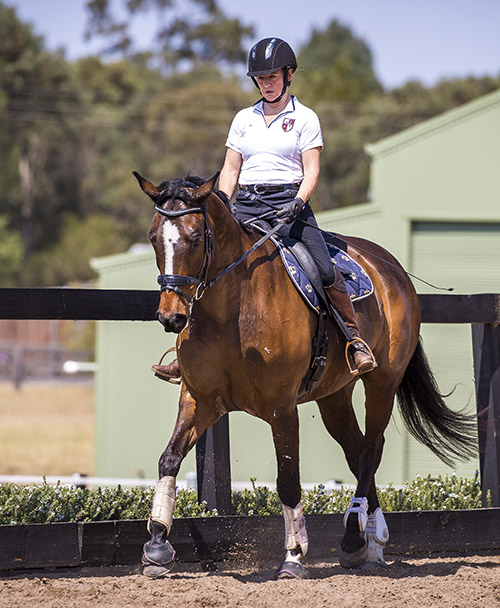
Debbie worried that when she gave the hand the poll went down, the solution: “Sit behind your hand and take your seat with your hand. Now he’s starting to move and soften his jaw. Good, there you go.”
After a break it was time for the canter, “Don’t pick him up. No need, keep your upper body in motion.” When Flash wanted to hide, “Get him to fill out the space in front instead of shortening the neck. Right. Now you can ask for more rhythm, not more speed, just that the entire horse works more, jumps more and responds more to your aids.”
Changes in tempo and the gelding started to get a little strong, “Don’t fight it, but wait for the back to supple. Keep your hands forward. More bend. Inside leg pushes a little bit outwards but make sure your outside leg isn’t losing the hindquarters. He needs to jump toward the outside rein without the outside rein coming back.”
“Think of the dynamics; let him rock through his neck. Forward with light hands. Careful with your rein. Now downward transition, it should be forward not backwards. If anything, click your tongue. He’s not supposed to stop, he’s supposed to move.
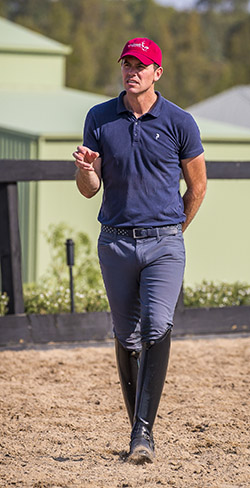
“I do understand that at the beginning it feels dull, but instead of trying to fix it and he gets more restricted, you’ve got to get him moving from behind instead, and then it will improve and he’ll get more supple and through and that will get the neck giving. If you correct it from the hand in front too much, it gets more restricted.”
There was still a bit more finessing to do at the trot to get the pair completely in synch.
“Sit up, chin in, just because his legs move quicker, doesn’t mean the back is giving. The seat keeps it all together even as your leg drives for impulsion. Not faster but more powerful. Don’t back off with your leg when you pick him up. Don’t stop riding. There you go. Exactly. Then he’s more giving in the poll. It’s not just forward, the point is that he responds more to you with more dynamics. Don’t confuse that with speed. Now you can bend and flex, but keep your priorities. The hand is the last in the chain of aids.”
“If he runs away from you, sit longer. Turn by giving with the inside rein to make room for the horse to come to the inside leg. Don’t pull with the inside rein. Now you have more push. Good.” Stefan also made sure that there was no loss of power during the transition. “If you lose pushing power, the contact becomes weaker and there is not enough for the horse to do the transition. The collecting aid is a half halt and that is pushing. Make your horse brave and strong.”
By the end of the session, Flash was really using his whole body and working from behind with a good over track showing back activity and the horse working forward into collection. Stefan gave us all food for thought challenging us to question ourselves everyday and to constantly develop our feeling as riders.
more follows
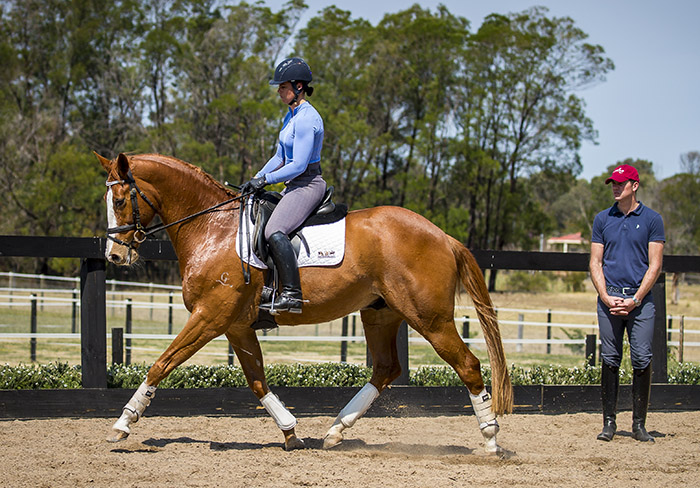
Holly Lewis was on her 12-year-old Heatherton Park Romeo. Straight away Stefan was after more ground cover without speed; a longer, smoother stride with no hesitation. “Low hands, let the neck drop. Let go. Don’t let him hesitate in the air.”
Holly complied and the ground cover improved while Stefan elaborated that the stride had to stay long so the horse didn’t snap its legs up. “The longer, lower, straighter the neck the better, especially for later on. Don’t fiddle around if he gets a bit solid in the neck. Good, now get a response once you get the ground cover. He should almost feel like he has a hard time to lift you up to the rise rather than you needing to pull back with the hand,” and again Stefan was looking for a good connection through the whole body of the horse, “a solid contact so that he can take your hand forward. Don’t give your hand so much though that he can no longer take it forward.”
Not too much, not too little. That’s riding right there!
Stefan also advised practising everything needed for high collection in the canter, rather than the trot, as it’s easier for the horse. It’s all about balancing the horse in tempo rather than just ‘collecting it up’ or else you’ll never be able to ride powerfully through a test.
There was a warning on the need to correct the little faults early before they turn into big problems. Dear Romeo was trying hard and offering a bit more than needed so Holly had to be aware and bring it all back a step, “Don’t get hung up on the idea that you need to ride that big, hovering trot or else it will backfire on you. I’m not going to be over critical, I just want to warn you or else you’ll notice too late the faults that can happen. One of those is rhythm faults. Especially a horse that offers it. Rhythm faults are the first thing, and then lameness. Develop a consciousness on how a horse uses it’s body. Is it a tight, flinching of the muscles or is the horse’s body roaming? He needs to keep moving his limbs. You can only bring him back if you can get him to not hesitate in the suspension phase.”
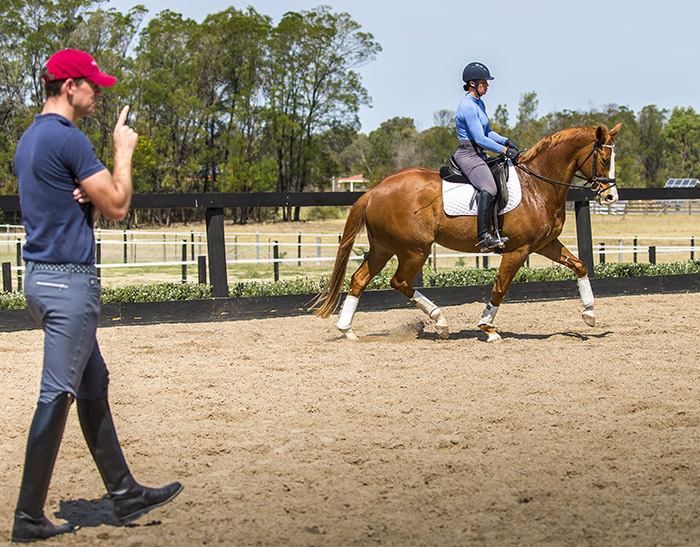
Stefan still wanted to play a bit more with the trot. “Sitting trot, not pushing, but keeping the seat without restricting the horse. Now you can use your leg more without him running away from it. You still want to improve his longitudinal forces because he wants to come up and back a bit. Hand forwards and use the leg until the stride gets longer. You want the feeling that the horse can touch your hand and you’ll let him take it forward a little.”
“If he gets too much, don’t come up with your hand and body, that is a driving aid and you end up holding him and you’ll compensate by pulling. Instead, move forward into the movement and hands lower and it’s easier for the horse to balance. I’m actually happy if he gets more. He’s a dressage horse! He needs to sparkle! You want the increased strength.”
“That’s the idea of pushing power. The horse will come back, you just need to be patient enough to wait for it. It’s a natural thing to happen. He’ll swing under your butt rather than rush off.”
Holly was listening to every word and has the skill to put it into practice immediately so we got to see instant changes in the horse. “Right. Now this is the beginning of cadence. Can you see the difference to what you had before? Now he starts swinging with the back. That’s a collected trot!”
A bit of walk was well deserved before some collected walk to canter transitions. Stefan encouraged, “Strong, solid neck, on your seat, more momentum but don’t over power him. Come, not shorter with the neck. Good frame now. Now he’s looking for it. Don’t forget it; don’t forget this feeling. Collection means more dynamic, more balanced. He consistently needs to press on your butt. Now do that in a slight medium canter on the circle. Good. Now he’s working though his body.”
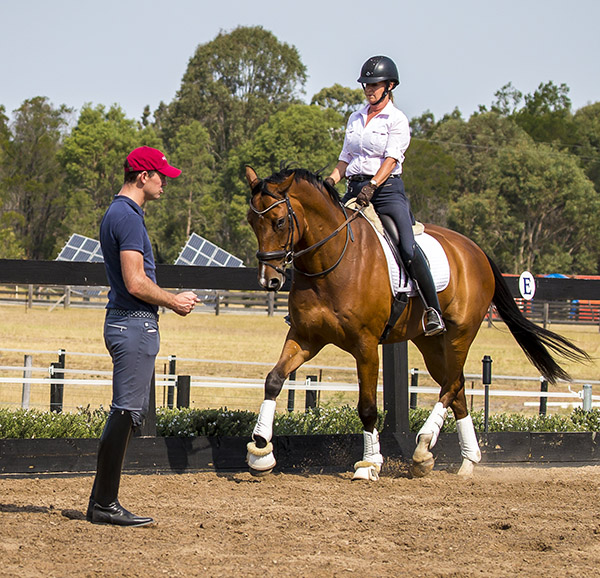
Caroline Hooper was on her eye catching Becks Gold II. The youngster wanted Caroline to help him out a little bit too much and Stefan focused on getting the gelding to lift up and out of his shoulder more and be more on his rider’s seat. “I want a normal trot where you can bring your hand further forward and he doesn’t run way. What you give in your hand you should gain in your seat. Longer rein and hand further forward. Give him the freedom to use the neck. The time that you’re sitting, really see it as a true sitting moment and try to stay there a little longer. Don’t shorten the rein as you give your hand forward. Don’t respond to every little sway of the line. Let him find himself a bit.”
“It was not a coincidence that the ears were pointing forward there all of a sudden. Now he comes into better balance and he looks for your leg. At the same time, try and get a bit of a response to your leg, yet not pushing him off the contact of your leg.” Allowing hand, waiting seat and demanding leg was the focus, “The more you have him on your seat and legs, the less you need your hand. Your hand does not need to come back.”
Up into the canter and like Holly’s horse before, ‘Ben’ needed to be a little more solid and steady in the neck and remain in front of Caroline’s hand. “Don’t fiddle with your hand to weaken that. You want it more to stabilise, until you get enough drive and dynamics to have him stretch over the top line. Then you have more of a positive influence.” And there it was, “Now he reaches through to the bit rather than have that slight hesitation.”
A walk was in order but Stefan didn’t want it so big that it no longer remained on the rider’s seat and leg. “Exactly. Now hand forward and more frame. Now turn on the haunches. Try and work a little more with the balance. He needs to work into the inside leg and not hesitate when it touches him. The key is to get the inside leg on. He needs to move toward the inside leg, not off it at this age. He needs to work into and around it.”
Back into the trot and Stefan wanted the horse to respond to Caroline’s leg but within the swing of the stride. “He needs to be in the right frame and on your seat before you use the leg. Keep the hand forward. Keep some weight over the neck. Use the whip right behind your heel and when you’re sitting. Too high is not good for him. Forward! Don’t chicken out! Don’t hold it. Your back has to hold it, not your hand. He doesn’t really have too much in your hand, but I want to be very exact so you don’t run into problems later.”
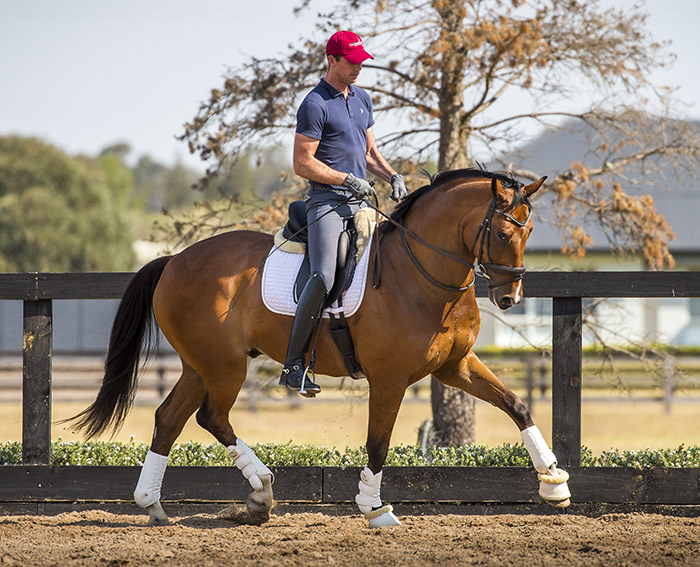
Then Stefan decided to jump on for a ride and there was no ambiguity as to what he wanted. Stay in front of my leg and respond! There were a few kicks and bounces from Ben but Stefan just stuck to his guns and waited; waited for the horse to release and move. And there it was, big, powerful movement without the horse coming back at the hand and remaining supple through its body. He was in balance and once he knew the game plan, it was pretty impressive. He’s a very willing horse.
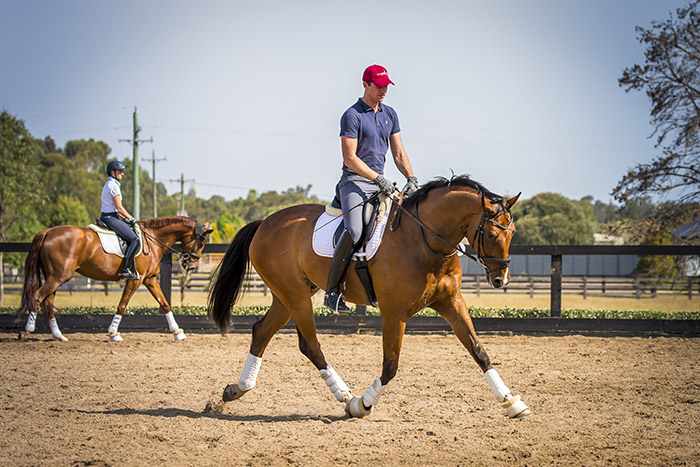
Caroline was back in the saddle and Stefan wanted her to just pop her hand forward and let the horse grow up and out in front and do things himself. “He needs to do it alone. He won’t run through the wall. If you don’t hold, you don’t need to make up with it with the leg. You don’t need much leg.” It’s not until you sit on such a big mover that you realise that it’s not as easy as it looks, but Caroline’s a professional and by the end of the session, there was a pair you’d better keep your eye in in the competition arena.
As always, Stefan is on the horse’s side and onto the riders to influence their horses correctly with clear, consistent aids that influence the horse but don’t push them away from the rider; letting the horse to get on with the job at home without the rider getting in the way and over organising. It all requires subtle, clever riding. This as well as catching and correcting faults early in the training help nip them in the bud so they don’t turn into big problems or even lameness later.
I hope that as you read this you noticed what an extraordinary trainer, Stefan Wolff is. Maybe you even asked the question – why are our dressage management team not using this man in a more organised way to help Australian dressage move down the path to international competitiveness?
There is a whole library of articles with Stefan just a click away…




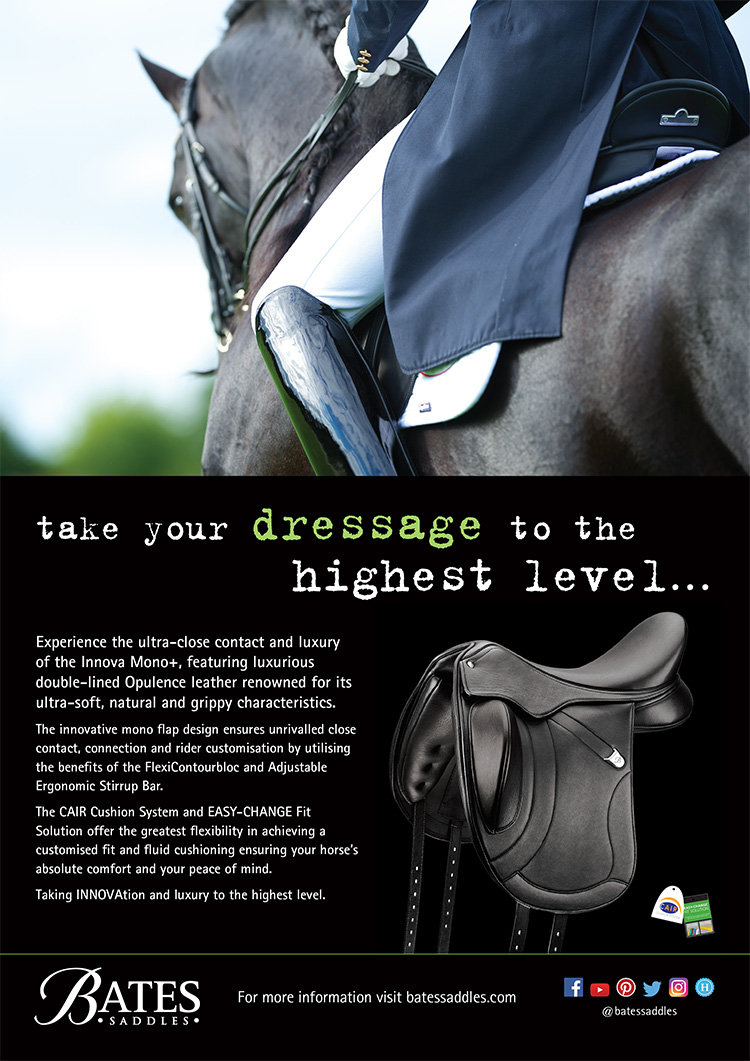
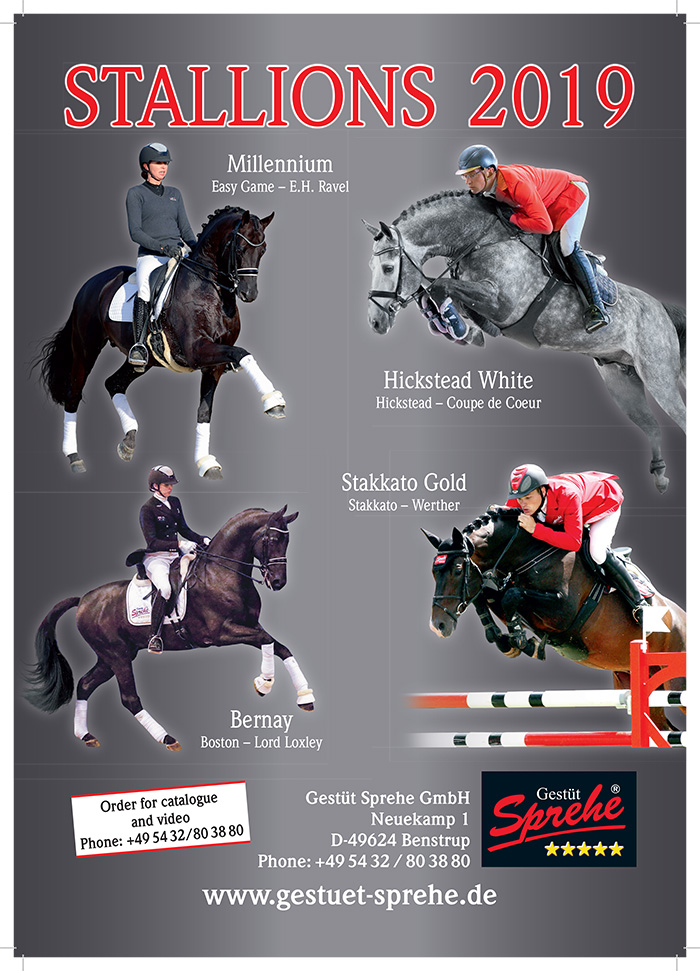

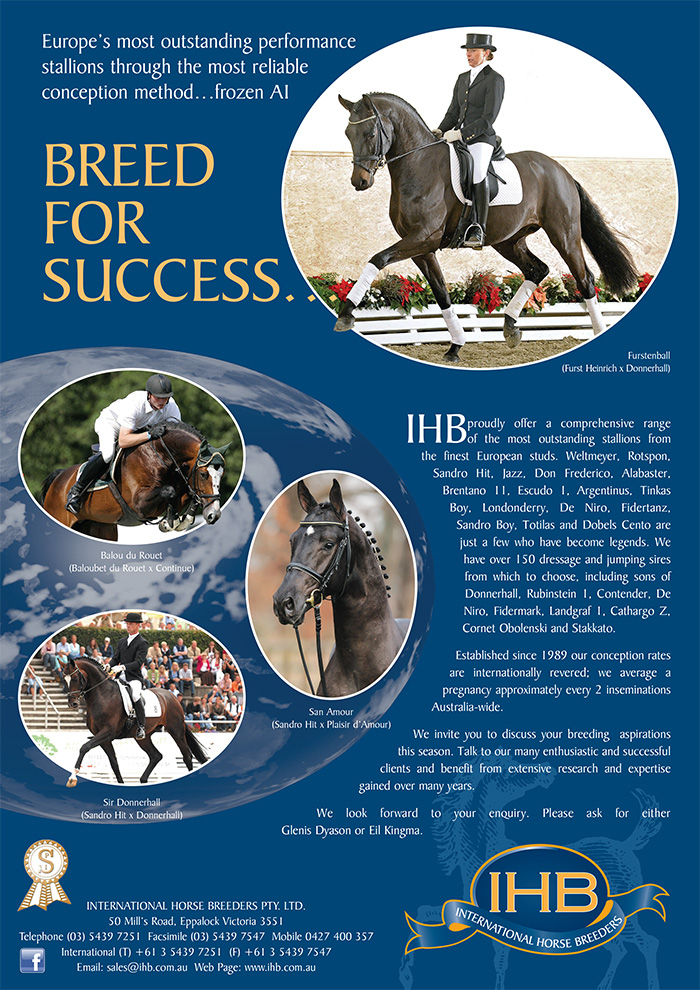
Great to see this approach we have a simplified system I call remedial flexion training that goes with my equinePHYSIOcare treatments , our system to start fixinging horses after or the physio work being done with some easy ground rules of inside flexion
Inside leg with a firm inside rein and neck bend ( not flexion to and fro with both reins) until the hand break comes off and the horse bowes to the knee.
This is an old European innovation I have over the year found it a game changer for many of our clients at http://WWW.HarperRoadequestrian.com
Thanks for In-depth article love to chat when you are in NZ